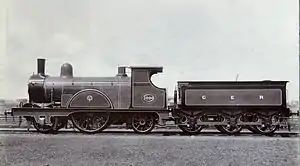GER Class D27
The GER Class D27 was a class of 2-2-2 steam tender locomotives designed by James Holden for the Great Eastern Railway.
| GER Class D27 | |||||||||||||||||||||||||||||||||||||
|---|---|---|---|---|---|---|---|---|---|---|---|---|---|---|---|---|---|---|---|---|---|---|---|---|---|---|---|---|---|---|---|---|---|---|---|---|---|
 GER 1000, the first of the 1893 batch | |||||||||||||||||||||||||||||||||||||
| |||||||||||||||||||||||||||||||||||||
| |||||||||||||||||||||||||||||||||||||
| |||||||||||||||||||||||||||||||||||||
| |||||||||||||||||||||||||||||||||||||
History
In 1888 Holden experimented by removing the side rods of T19 No. 721 to form a 2-2-2.[1] In 1889 the first of a new class appeared: initially No. 740 (later 789 and 780) which had been built on a 'Locomotive and Machinery' account. This was followed by two batches of ten on the more normal 'Letter' account.[2] in 1893. They were built with 18-by-24-inch (457 mm × 610 mm)[3] inside cylinders powered by a 140-pound-force-per-square-inch (965 kPa) boiler. They were later rebuilt with 18-by-25-inch (457 mm × 635 mm) and 160-pound-force-per-square-inch (1,103 kPa) boilers.[2]
| Year | Order no. | Manufacturer | Quantity | GER Nos. | Notes |
|---|---|---|---|---|---|
| 1889 | LM68 | Stratford Works | 1 | 740 | Renumbered 789, then 780 |
| 1891 | D27 | Stratford Works | 10 | 770–779 | |
| 1893 | F32 | Stratford Works | 10 | 1000–1009 | |
One of their main spheres was on the Joint Line working expresses to York. In 1896 the class inaugurated the epic making non-stop run to North Walsham using oil-firing. Rous-Martin[4] found that the singles climbed Brentwood Bank more rapidly than the 2-4-0s. See also Ahrons (1951).
Nine locomotives were withdrawn between 1901 and 1903. The surviving eight locomotives in the 770-series were transferred to the duplicate list in July 1904, and had their number prefixed with a "0". The remaining fourteen were withdrawn between 1904 and 1907.[5]
| Year | Quantity in service at start of year | Quantity withdrawn | Locomotive numbers |
|---|---|---|---|
| 1901 | 21 | 4 | 1000, 1002, 1005, 1007 |
| 1902 | 17 | 3 | 773, 1001, 1003 |
| 1903 | 14 | 2 | 1008, 1009 |
| 1904 | 12 | 4 | 775, 0771, 1004, 1006 |
| 1905 | 8 | 4 | 0772, 0774, 0777, 0780 |
| 1906 | 4 | 1 | 0770 |
| 1907 | 3 | 3 | 0776, 0778, 0779 |
References
- Allen 1961, p. 114
- Aldrich 1969, p. 34
- Rous-Marten 1902, p. 272
- Rous-Marten 1898a
- Aldrich 1969, p. 35
- Ahrons, E. L. (1951). Asher, L. L. (ed.). Locomotive and train working in the latter part of the nineteenth century. (Volume 1). Cambridge: Heffer.
- Aldrich, C. Langley (1969). The Locomotives of the Great Eastern Railway 1862–1962 (7th ed.). Wickford, Essex: C. Langley Aldrich. OCLC 30278831.
- Allen, C. J. (1961). The Great Eastern Railway, 3rd edition (3rd ed.). London: Ian Allan.
- Rous-Marten, C. (1898a). British express engines. Int. Rly Congress.
- Rous-Marten, C. (1902). Railway Magazine. 11: 272. Missing or empty
|title=(help)
External links
| Wikimedia Commons has media related to GER Class D27. |
- J. Holden locomotives – Great Eastern Railway Society